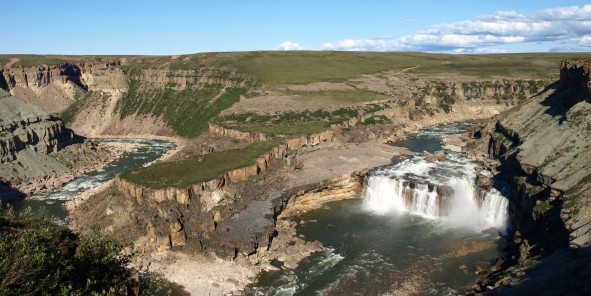National parks are established to protect and present the natural and cultural heritage of the region. Leave Tuktut Nogait National Park in as good, or better, condition than you found it.

© Parks Canada & Arron Previas
Respect Flora and Fauna
Enjoy and observe wildlife from a distance. Do not follow, approach or feed animals. Feeding wildlife damages their health, alters natural behaviours, and exposes them to predators and other dangers. Store your food, waste, toiletries and cooking equipment so it is inaccessible to wildlife. It is an offense for visitors to hunt, disturb, hold in captivity or destroy wildlife or their nest, lair or den within the park. Visitors are not permitted to carry firearms in the national park.
Enjoy, look and leave plants, bones, feathers, antlers and other natural objects as and where you find them.
Respect Cultural Resources
Parks Canada strives to protect, and promote an understanding of, the cultural history of our national parks. Historic sites and artefacts are clues that combined can give us increasingly valuable insight into past and present cultures. Look, record and leave all artefacts, bones and human remains exactly as you find them. In fact, under the Canada National Parks Act, it is illegal to remove, destroy or deface any cultural artefacts. Please report any disturbance of artefacts or historic sites to Parks Canada. Your care and respect will ensure that the heritage of the Western Arctic is here to be discovered and enjoyed for generations to come.
Maintain Pristine Water
Ensure all washing (bodies, clothes and dishes) is carried out away from fresh water sources Dispose of grey water at least 30 meters from drinking water sources. Use only biodegradable soap.
Management of Human Waste
Bacterial action is slow in the Arctic. Solid human waste can take a long time to decompose. The preferred human waste management method is packing it out. Numerous waste disposal products exist that offer effective, portable, low-cost options for the safe, lightweight collection, transportation and disposal of solid human waste. Where it is not feasible observe the following practices:
- Defecate well away from campsites and trails, and at least 50 metres (about the length of an ice hockey rink) from freshwater sources;
- Leave faeces exposed on tundra;
- South facing sites may accelerate decomposition and are preferred sites for defecation;
- Either pack out toilet paper or burn it in small bundles as you use it. Always burn toilet paper on durable ground, well away from vegetation. Avoid burning large loads of toilet paper at any one time;
You are not required to pack out urine. However, the introduction of human urine into freshwater sources should be minimized by urinating at least 50 metres from freshwater sources. To avoid attracting wild animals urinate away from campsites and trails on well drained rocky or gravely sites.
Minimize packaging before arriving at the park as all items that you pack into the park you must pack out including packaging, feminine hygiene products, and biodegradable food scraps such as orange peels.
- Date modified :